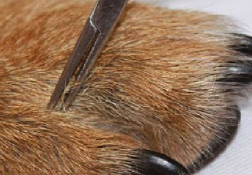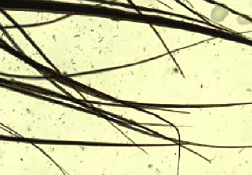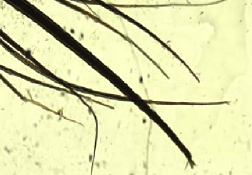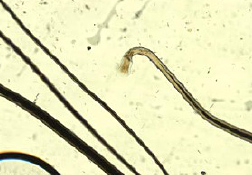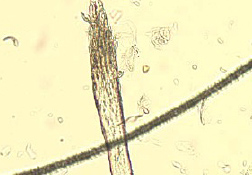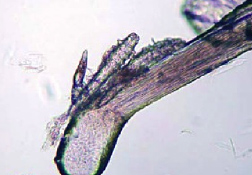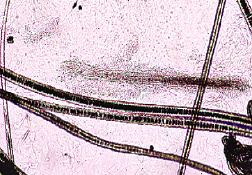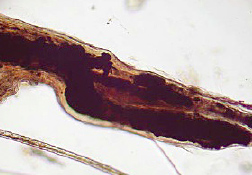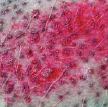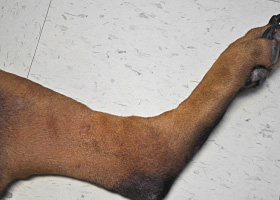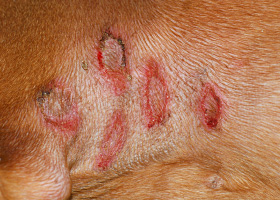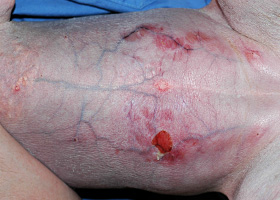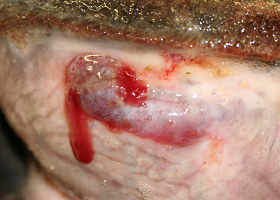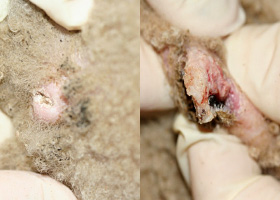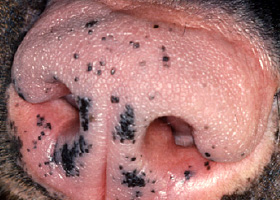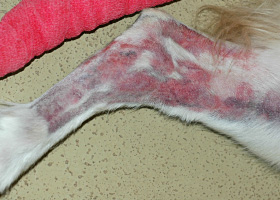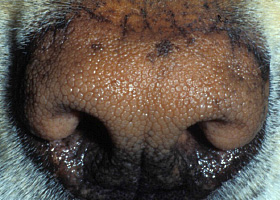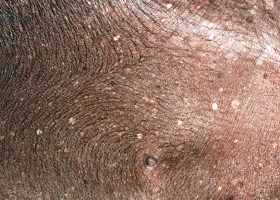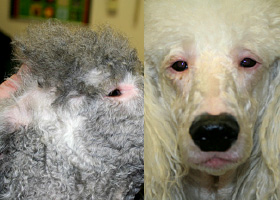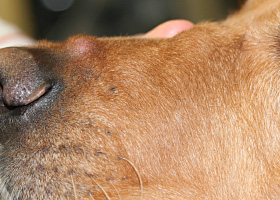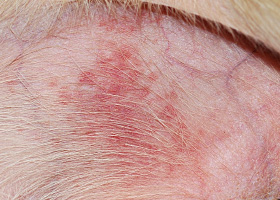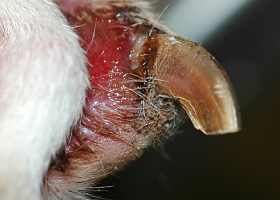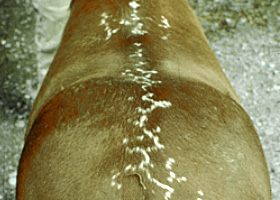トリコグラム法
いつ行うか?
- 脱毛のあるすべての患畜に行う。
- 自己誘発性脱毛を疑う場合、被毛先端の裂けを見つけるために実施する。
- 被毛がアナゲン期、テロゲン期のうちいずれの段階にあるのかを判断するために実施する(犬のアナゲン期被毛とテロゲン期被毛の比率に関する解釈は品種および季節に左右されるものであり、正確な数字は出されていない)。
- 皮膚糸状菌症が疑われる場合
- 被毛の色が薄くなった犬を特定するために実施する。
- ニキビダニ属が疑われる場合に深部皮膚擦過法の代替法として実施する。
何を見つけるか?
- 被毛先端の裂け→自傷が原因である。
- 被毛先端の先細り→脱毛は毛包内の事象(内分泌障害または毛包を冒す炎症)によって起こる。
- アナゲン(成長)期の被毛→アナゲン期の被毛の毛根は円形で、渦を巻き、曲がっており、平滑で色素が沈着しているものが多い。
- テロゲン(休止)期の被毛→テロゲン期の被毛の基部はでこぼことして端がブラシ様となっているが、毛根はランセット形で着色はみられない。
- アナゲン期の被毛が多数存在する場合は、内分泌障害の疑いが少なくなる。
- 皮膚糸状菌症の症例では、罹患した被毛が胞子で覆われ、菌糸の侵入がみられる。
- 淡色被毛脱毛症→毛幹にメラニンの凝集がみられる。
何が必要か?
- 鉗子/止血鉗子またはゴムで覆ったクランプ、ミネラルオイル、スライド、カバーガラス、顕微鏡
どのように行うか?
- 鉗子/クランプを用いて、部分的または完全に脱毛した領域の被毛を数本、被毛の発育方向に引き抜く。鉗子/クランプを皮膚表面に近づけ、表面に現れている被毛をすべて掴む。
- ミネラルオイルを1滴スライドに落とし、引き抜いた被毛をミネラルオイル上に並行に置き、毛根と先端を十分に評価できるようにばらばらに分ける。
- 被毛をカバーガラスで覆い、顕微鏡で観察する。
ヒント
- 毛幹がつぶれたり折れたりしないよう、鉗子またクランプの先端をゴムまたはシリコンスリーブで覆う。
- トリコグラム法を用いれば、擦過が困難な罹患領域(眼の近傍、足皮膚炎)のニキビダニを発見することもできる。理想では、皮膚擦過法と同じ1~2 cm2内から引き抜くとよい。
- ニキビダニ属ダニが被毛にくっついていたり、時には被毛の裏に隠れていたりするのが見つかることもある。結果が陽性であった場合のみ、診断を下すことができる。
- シラミやCheyletiella属ダニおよびその卵が見つかることもある。
abscess
A discrete swelling containing purulent material, typically in the subcutis
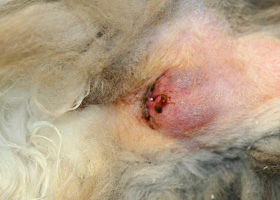
Perianal abscess in a dog
alopecia
Absence of hair from areas where it is normally present; may be due to folliculitis, abnormal follicle cycling, or self-trauma
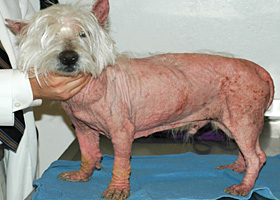
Extensive alopecia secondary to cutaneous epitheliotropic lymphoma
alopecia (“moth-eaten”)
well-circumscribed, circular, patchy to coalescing alopecia, often associated with folliculitis
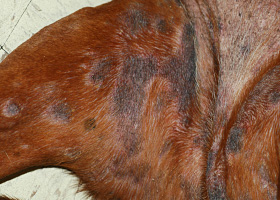
“Moth-eaten” alopecia secondary to superficial bacterial folliculitis
hemorrhagic bullae
Blood-filled elevation of epidermis, >1cm
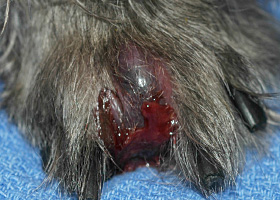
Interdigital hemorrhagic bulla in a dog with deep pyoderma and furunculosis
comedo
dilated hair follicle filled with keratin, sebum
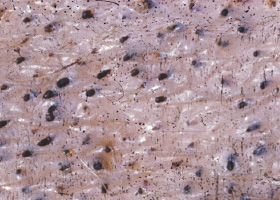
Comedones on the ventral abdomen of a dog with hypercortisolism
crust
Dried exudate and keratinous debris on skin surface
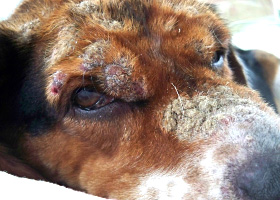
Multifocal crusts due to pemphigus foliaceus
epidermal collarettes
Circular scale or crust with erythema, associated with folliculitis or ruptured pustules or vesicles
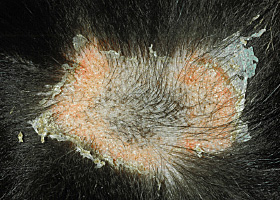
Epidermal collarettes in a dog with Staphylococcus superficial bacterial folliculitis
erosion
Defect in epidermis that does not penetrate basement membrane. Histopathology may be needed to differentiate from ulcer.
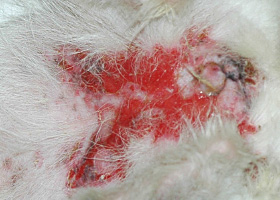
Erosions in a dog with vasculitis
erythema
Red appearance of skin due to inflammation, capillary congestion
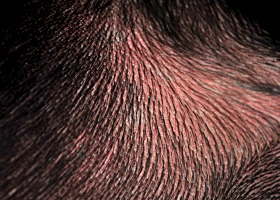
Erythema in a dog with cutaneous drug eruption
eschar
Thick crust often related to necrosis, trauma, or thermal/chemical burn
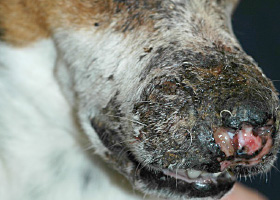
Eschar from physical trauma
excoriation
Erosions and/or ulcerations due to self-trauma
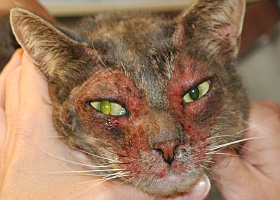
Excoriations in a cat with atopic dermatitis
fissure
Excessive stratum corneum, confirmed via histopathology. This term is often used to describe the nasal planum and footpads.
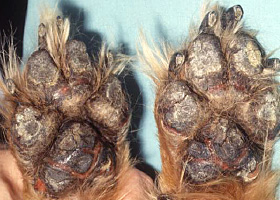
Fissures of the footpads in a dog with superficial necrolytic dermatitis
fistula
Ulcer on skin surface that originates from and is contiguous with tracts extending into deeper, typically subcutaneous tissues
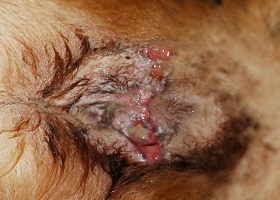
Perianal fistulas in a dog
follicular casts
Accumulation of scale adherent to hair shaft
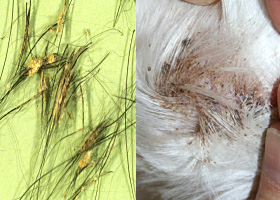
Follicular casts surrounding hairs from a dog with hypothyroidism
hyperkeratosis
Excessive stratum corneum, confirmed via histopathology. This term is often used to describe the nasal planum and footpads.
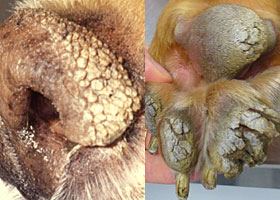
Idiopathic hyperkeratosis of the nasal planum (left) and footpads (right)
hyperpigmentation
Increased melanin in skin, often secondary to inflammation
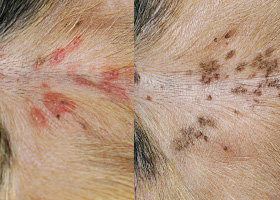
Inflammatory lesions (left) resulting in post-inflammatory hyperpigmentation (right)
hypotrichosis
Lack of hair due to genetic factors or defects in embryogenesis.
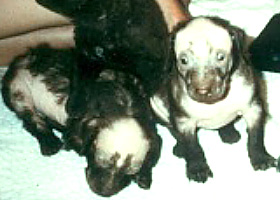
Congenital hypotrichosis in chocolate Labrador puppies.
lichenification
Thickening of the epidermis, often due to chronic inflammation resulting in exaggerated texture
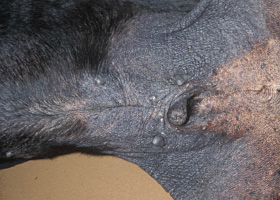
Lichenification of skin in a dog with chronic atopic dermatitis and Malassezia dermatitis
macule
Flat lesion associated with color change <1cm
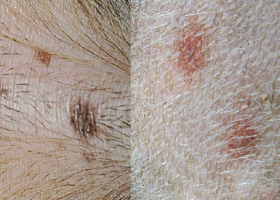
Pigmented macule (left) Erythematous macule (right)
melanosis
Increased melanin in skin, may be secondary to inflammation.
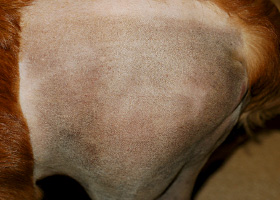
Post inflammatory hyperpigmentation of this dog’s thigh
miliary
Multifocal, papular, crusting dermatitis; a descriptive term, not a diagnosis
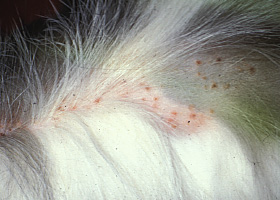
Miliary dermatitis in a flea allergic cat
morbiliform
A erythematous, macular, papular rash; the erythematous macules are typically 2-10 mm in diameter with coalescence to form larger lesions in some areas
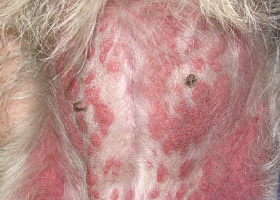
Morbiliform eruptions in a dog with a cutaneous drug reaction
onychodystrophy
Abnormal nail morphology due to nail bed infection, inflammation, or trauma; may include: Onychogryphosis, Onychomadesis, Onychorrhexis, Onychoschizia
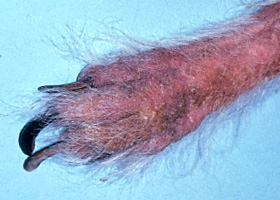
Onychodystrophy in dog with chronic allergies
onychogryphosis
Abnormal claw curvature; secondary to nail bed inflammation or trauma
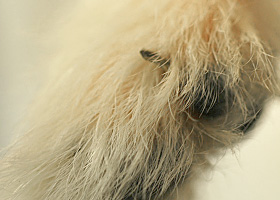
Onychogryphosis in a dog with symmetric lupoid onychodystrophy
onychomadesis
Claw sloughing due to nail bed inflammation or trauma
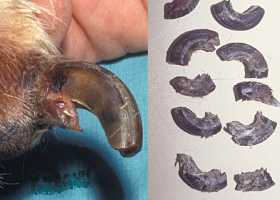
Onychomadesis in a dog with symmetric lupoid onychodystrophy
onychorrhexis
Claw fragmentation due to nail bed inflammation or trauma
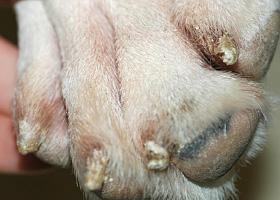
Onychorrhexis in a dog with symmetric lupoid onychodystrophy
onychoschizia
Claw splitting due to nail bed inflammation or trauma
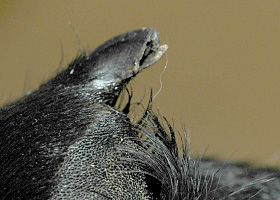
Onychoschizia in a dog with symmetric lupoid onychodystrophy
patch
Flat lesion associated with color change >1cm
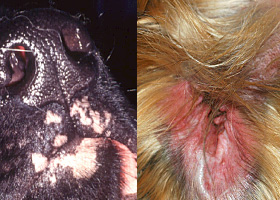
Hypopigmented patch (left), erythematous patch (right)
petechiae
Small erythematous or violaceous lesions due to dermal bleeding
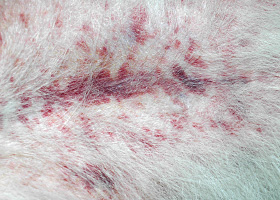
Petechiae in a dog with cutaneous vasculitis
phlebectasia
Venous dilation; most commonly associated with hypercortisolism
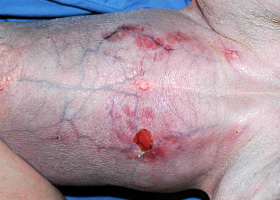
Phlebectasia and cutaneous atrophy due to hypercortisolism in a dog
plaques
Flat-topped elevation >1cm formed of coalescing papules or dermal infiltration
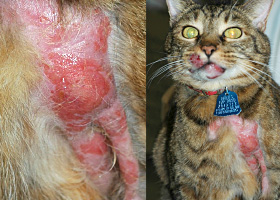
Plaques in a cat with cutaneous lymphoma
pustule
Raised epidermal infiltration of pus
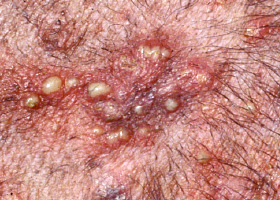
Pustules on the abdomen of a dog with superficial staphylococcal pyoderma.
scale
Accumulation of loose fragments of stratum corneum
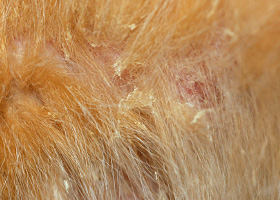
Loose, large scales due to ichthyosis in a Golden Retriever
scar
Fibrous tissue replacing damaged cutaneous and/or subcutaneous tissues
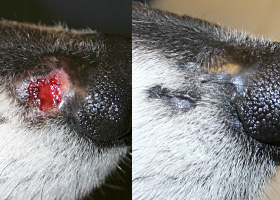
Scarring (right) following the healing of an ulcer (left) in a dog with sterile nodular dermatitis
serpiginous
Undulating, serpentine (snake-like) arrangement of lesions
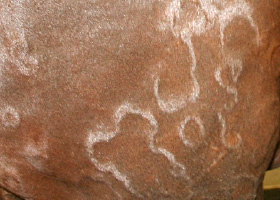
Serpiginous urticarial lesions on a horse
telangiectasia
Permanent enlargement of vessels resulting in a red or violet lesion (rare)
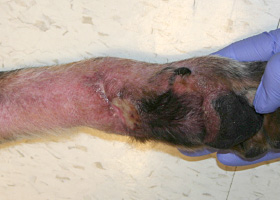
Telangiectasia in a dog with angiomatosis
ulcer
A defect in epidermis that penetrates the basement membrane. Histopathology may be needed to differentiate from an erosion.
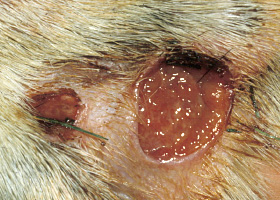
Ulcerations of the skin of a dog with vasculitis.
urticaria
Wheals (steep-walled, circumscribed elevation in the skin due to edema ) due to hypersensitivity reaction
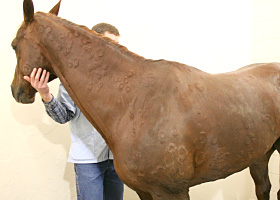
Urticaria in a horse
vesicle
Fluid-filled elevation of epidermis, <1cm
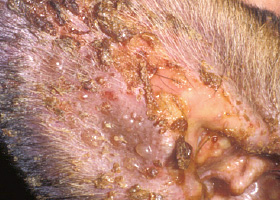
Vesicles and bullae on ear pinna due to bullous pemphigoid
wheal
Steep-walled, circumscribed elevation in the skin due to edema
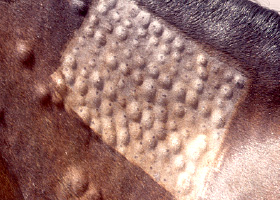
Wheals associated with intradermal allergy testing in a horse


